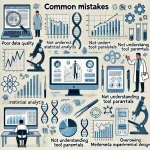
Cracking the Code of Life: How Computing Became the Game-Changer for Bioinformatics
August 24, 2023The Starting Line: Early Computational Biology
Bioinformatics didn’t just appear out of the blue; it has its origins in computational biology, which got its start around the 1960s. Back then, researchers were already using computers to simulate life processes, but they were held back by the technological limitations of the time.
A Union of Fields
Fast forward to the late ’80s and early ’90s, and you’ll see how computer science really kicked things into high gear. With a surge in genomic data and leaps in computer technology, there was a pressing need to manage heaps of biological information. That’s when computing stepped up to the plate, offering ways to store, fetch, and crunch all that data.
The Nuts and Bolts: Algorithms and Data Frameworks
Core computing ideas like algorithms and data structures became the skeleton of bioinformatics. Techniques like BLAST for lining up sequences and Hidden Markov Models for guessing genes demonstrated how computing smarts could tackle intricate bio puzzles.
Storing and Sifting Through Data
Bioinformatics also took a page out of the computer science book when it came to holding and retrieving data. Biodatabases like GenBank popped up to house truckloads of gene data. Plus, data mining methods were tweaked to comb through these massive data stores and spot useful trends.
Doubling Down with Parallel Computing
As the data layers got more intricate, the demand for beefy computing also shot up. Enter parallel computing, which let bioinformatics folks run heavy-duty calculations and models way quicker than before.
The Open-Source Wave: A Boost in Momentum
The open-source trend in computing also played a big role. Tools like R and Python libraries gained traction in bioinformatics, mainly because they were free to use and could be tailored to specific needs.
Wrapping It Up
Computer science did more than just toss in some handy tools; it reshaped how bioinformatics pros tackled challenges. It turned the field from mostly a think-tank space into a hands-on science, deeply meshed with tech.


















